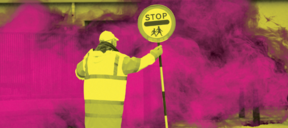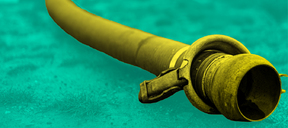Wasted Wetlands: Pumping of bogs by Bord na Móna 'hampering rehabilitation'
Environmentalists say the semi-state’s pumping practices in Co Longford are harming the habitats of birds of conservation concern.

ENVIRONMENTAL GROUPS ARE concerned that Bord na Móna’s continued pumping of water from a number of bogs is hampering promised rehabilitation efforts.
The activists say this is also causing damage to wildlife habitats on the bogs and surrounding farmland in the midlands.
For our WASTED WETLANDS investigation, Noteworthy examined the State’s failure to do enough to tackle commercial exploitation of Ireland’s wetlands despite EU commitments to restore them as a key weapon in battling the dual climate and biodiversity crisis.
Three of the Longford bogs – Derryadd, Derryarogue, and Lough Bannow – are the site of the proposed Derryadd wind farm project, but local and national environmental groups say that this development will have a seriously detrimental effect on the area. They are calling for a rehabilitation of the site, rather than further development.
Bord na Móna has said that they are currently in the process of rehabilitating these bogs in line with its Peatlands Climate Action Scheme. However, environmental groups say that the pumping practices on the sites in question are at odds with how rehabilitation has been carried out on other bogs.
One proposed alternative option for the area, which local groups are still advocating for, is the creation of the Mid-Shannon Wilderness Park, first mooted by Longford County Council in 2013.
According to Minister for the Environment Eamon Ryan, the park is still on the table, but has been folded into the Lough Ree Biosphere project.
Bord na Móna is committed to the construction of a wind farm, and says that “the most appropriate climate change solution and optimum land use for the site continues to be a project combining wind energy, amenity and rehabilitation”.
However, according to Fintan Kelly from the Irish Environmental Network (IEN), the position is not straightforward.
“The peat [in Derryadd] had run out and so they had to do something with the site. Under the Integrated Pollution Control (IPC) licence they are required to hold from the EPA, the site must be rehabilitated once extraction operations have ceased.
“However, this requirement is so loose, that rehabilitation effectively just means ‘not actively causing pollution’, and so they decided to build wind farms, despite the damage that this does by degrading peat,” he claimed.
Bord na Móna did not respond directly to these allegations, but said it is currently entering into a rehabilitation phase on the Derryadd site.
According to a spokesperson, this involves “raising water levels close to the surface of the bog, stabilising the bare peat surface, slowing water movement across the bog, trapping mobile silt and supporting the development of compatible habitats”.
The European Commission has been reprimanding Ireland for ongoing damage to peatlands, including turf cutting, for a number of years. Just last month it referred Ireland to the European Court of Justice due to efforts by Irish authorities to date being “insufficient”.
- Noteworthy previously investigated industrial peat extraction in our multi-part PEAT’S SAKE series which you can read here >>
The Derryadd site is a former raised bog, so this is significant as in 2022 the Commission found that restoration activities had begun “on some raised bogs”, but stated that this was “too slow given the importance of this priority habitat and its precarious state”.
 Noteworthy visited the Derryadd bog in January 2024.
Noteworthy visited the Derryadd bog in January 2024.
Noteworthy, the crowdfunded community-led investigative platform from The Journal, supports independent and impactful public interest journalism.
Continuous pumping needed for wind farm development
In order for a wind farm to be built on peatland, the area must be drained, which causes the peat on the site to degrade, releasing carbon into the atmosphere.
The amount of carbon stored in global peat is significant, with northern peatlands - which cover 2% of the world’s landmass - storing twice the amount of carbon as northern (boreal) forests, even though these forests cover four times more land (8%).
The Derryadd site has previously been the subject of one application for a 24-turbine wind farm. Permission was granted in 2020, but was quashed by the High Court on appeal in 2021 due to the turbine design not being specific enough.
Due to the site’s close proximity to the River Shannon, the area floods more quickly when compared to other peatland sites in the Midlands.
Therefore, to make the site more suitable for wind farm development, the water level must be kept at a level much lower than normal. This is done via pumping the water out of the bogs and into local waterways.
The volume of water pumped out of the site is staggering.
A local environmental group, the Mid-Shannon Wilderness Park Awareness Group has identified 17 pumps and augers (screw-shaped infrastructure that pulls water out of the bog) across the three bogs at the site.
Campaigners fear that the level of water being removed will mean that the site cannot be effectively rehabilitated.
Peat is produced when sphagnum moss is able to grow on partially decayed organic matter that has been preserved in a flooded area. However, if the area is drained and not sufficiently wet, there isn’t enough water to prevent decay, so the sphagnum moss, and therefore the peat, cannot recur – an essential part of rehabilitation of harvested peatland.
This results in the bog becoming a carbon emitter instead of a crucial carbon store.
Under Bord na Móna’s IPC licence required for peat extraction, a site must be rehabilitated once it comes out of production. Kelly believes that the current pumping regime could be “at odds with their general approach to rehabilitation”.
More plans for the site are afoot. In February 2024, Bord na Móna submitted a request to enter into pre-application consultation with An Bord Pleanála.
When Noteworthy asked what potential development this was in relation to, a Bord na Móna spokesperson said that “the purpose of the application is to support Bord na Móna’s current mission, which is entirely focused on renewable energy generation, recycling, peatlands restoration and the development of low carbon enterprises”.
 Part of the proposed site for the Derryadd windfarm.
Part of the proposed site for the Derryadd windfarm.
Birds of conservation concern inhabit the bogs
A major concern that environmentalists like Kelly have is that the three bogs on the Derryadd site are important habitats for a number of protected bird species.
Kelly and others fear that by making the site less attractive to species like the wintering Whooper swans, planning approval for a wind farm will be more easily attained.
But Bord na Móna insists that peatland restoration is a “key part” of its transition to renewable energy, and that this includes the “revival of various plant and wildlife species”.
One of the species that inhabit the bogs, Whooper swans, are on Birdwatch Ireland’s amber-list of birds of conservation concern. They typically travel from Iceland for the winter and peat bogs across the Midlands are one of their key habitats.
Whooper swans are well documented on the Derryadd site, as they regularly nest next door, in the Lough Ree Special Protection Area (SPA). The swans rest and feed at various points across Derryadd.
When Noteworthy visited the site during the winter, we observed Whooper swans in a number of locations, both on waterways and feeding in nearby farmland.
While the proposed Derryadd site lies outside of the Lough Ree SPA, Whooper swans are a species listed under the Natura 2000 framework, and so are a protected species even outside designated SPAs.
 Whooper swans, pictured here flying in England, are birds of conservation concern.
Whooper swans, pictured here flying in England, are birds of conservation concern.
In its submission to the now quashed planning application, Birdwatch Ireland considered the survey of Whooper swans carried out on behalf of Bord na Móna to be “inadequate”.
The charity wrote that the surveys only covered the “proposed development site and that visits to the lake shore of Lough Ree were infrequent”. It also stated: “There was no reference to systematic surveys outside of the development site boundary.”
Fintan Kelly, who worked for Birdwatch Ireland at the time, prepared the submission. He said, in his view, the ecological assessment prepared as part of Bord na Móna’s planning application to be “one of the worst I’ve seen” in relation to bird life.
When this was put to Bord na Móna, a spokesperson said that the assessment was carried out by a team of “competent experts” and complied with all relevant guidance and requirements.
They went on to say: “An Bord Pleanála considered all information submitted during the planning process, and consent was granted in May 2020.”
Birdwatch Ireland completed its own survey and its submission stated that the numbers of birds found across the three bogs far exceeded the average for eight of the other important wintering sites across Co Longford.
The Derryadd site was host to flocks of upwards of 148 birds, compared to other recognised sites like Lough Ree (114), Lough Forbes (61) and Lough Gowna (52).
While the ecological assessment in the planning application did recognise that a flock of 148 birds was observed on the site during the winter of 2015/16, it stated that this was below 150 birds.
A UN convention deems wetlands as internationally significant if at least 1% of the population of a species resides on it – in this case 150 Whooper swans.
The Birdwatch Ireland submission considered this 148 number to be consequential, even if it fell two below this threshold. In this context, the volume of pumping on the Derryadd site is significant, according to Kelly.
This sentiment is shared by local groups including the Mid-Shannon Wilderness Park Awareness Group.
Niall Dennigan, its spokesperson, said that the pumping is vital for any future planning applications that Bord na Móna intends to put through. He told our team:
It’s very difficult to get planning permission when wildlife are present on the land, particularly rewet bogs.
He expressed concern that if those wildlife numbers were lower on the bogs, it might make the granting of permission more likely.
Despite the importance of the habitat to wildlife, in response to a query from Noteworthy, Bord na Móna said that the current level of pumping is necessary to maintain the water at a level that will encourage rehabilitation, as well as protect surrounding farmland from potential flooding if the water table rises too high.
 The water table before pumping (below) and after pumping (above).
The water table before pumping (below) and after pumping (above).
Extent of pumping ‘simply not required’
During the Covid-19 pandemic, Dennigan says that works on the site were forced to stop, and with this came a pause in pumping.
“What we saw in those 12 months alone was a return of the water table to its natural level, and with that came a return of the bird life.
“We were counting hundreds of Whooper swans across the three sites, along with mute swans, curlews, and a number of others,” he said.
Bord na Móna did not directly respond to our queries about the effect of the pumping on habitats.
A spokesperson did say that the pumping is part of a scheme which “aims to rehabilitate drained peatlands for improved climate, environmental, ecological and hydrological impacts – including restored biodiversity and the revival of various plants and wildlife species”.
Dennigan expressed concern, and said that this is contrary to the evidence on the ground that the Mid-Shannon Wilderness Park Awareness Group has seen and collected which suggests that Bord na Móna’s efforts are insufficient to protect wildlife. He said “the extent of pumping is simply not required” and added:
During the highest water levels witnessed by us, when pumping was not taking place, the water flow found its way to outfalls and did not impact neighbouring lands, meaning natural control was sufficient.
He added that, if required, Bord na Móna can also raise the water height at which the pumps activate and deactivate “to completely eliminate the extreme pumping currently taking place to a more acceptable and environmentally friendly standard”. This would “further facilitate neighbouring lands, all while providing sufficient re-wetting and keeping habitats intact”.
Material collected by the Mid-Shannon Wilderness Park Awareness Group suggests that the water being pumped out may be too much for the Lehery River, where much of the water is pumped to.
On whether pumping could have caused flooding of that river, a spokesperson for Bord na Móna said that “the [water] contribution from the Derryadd bog represents < 1% of the total Shannon Catchment area, and therefore does not significantly impact water levels”.
Ranger’s evidence of nesting season impact
In addition to the Mid-Shannon Wilderness Park Awareness Group, a local ranger of the National Parks and Wildlife Service (NPWS) also raised concerns about the current pumping regime on the Derryadd site.
In 2022, the ranger told Bord na Móna they had observed a number of lapwings displaying territorial behaviour on the site, as seen in documentation obtained through an AIE request to the Department of Housing by Noteworthy.
They wrote that it was an important nesting site for the species and that the pumping was keeping the water level too low for them to nest safely.
Lapwings nest on peat islands at the centre of bogs that are usually inaccessible to predators. These islands become accessible, and therefore too dangerous for the birds to nest on, when the water level is pumped to the extent that it is at Derryadd.
In 2023, the local ranger again contacted Bord na Móna as pumps were continuing to operate in the summer months after a period of dry weather, while lapwing chicks were nesting on peat islands on the site.
In their report, they stated that a Bord na Móna staff member told them the pumps were already off in May 2023, but around three weeks later the ranger found this not to be the case.
Bord na Móna said it would investigate and the ranger found the pumps were turned off when they visited again in mid-June.
The ranger also requested the semi-state to check the lapwings had fledged before resuming pumping later that month.
We asked Bord na Móna about pumping during lapwing-nesting-season and whether it would happen again this summer, but it did not reply to this query.
They did say that “pumps must remain in use until the hydrological assessment has been carried out”, which must then be approved by the National Parks and Wildlife Service, though they did not specify how pumping would be managed by season.
When Noteworthy visited the site in January (outside of this nesting season), we saw a number of pumps, all of which were active and pumping water out of the bogs.
 An auger (left) and pump (right) on the Derryadd site.
An auger (left) and pump (right) on the Derryadd site.
In documentation released to Noteworthy under AIE, Bord na Móna said that pumping will likely have to be maintained as part of any rehabilitation programme.
This is until “the hydrological assessment referred to above has been carried out and rehabilitation has been designed, subjected to public consultation and approved by the Scheme Regulator (NPWS)”. It stated:
The pump decommissioning generally occurs on completion of the bog rehabilitation measures.
However, Dennigan and Kelly point out that this is inconsistent with rehabilitation efforts on other bogs.
“The current pumping regime drives the water table down and removes habitats,” said Dennigan.
“These bogs are naturally wet, and will always rewet due to their proximity to the River Shannon, which is why Bord na Móna needs to continue a pumping practice that was intended solely for peat extraction.”
Updated Apr 5th, 11:00 AM: To include additional Bord na Móna response.
—
Read more articles in this series >>

Are renewables on peatlands causing more harm than good?

By Steven Fox for Noteworthy
This investigation was proposed and part-funded by our readers. It was developed with the support of Journalismfund Europe as part of a cross-border project with: Maria Delaney (Editor, Ireland); Swantje Furtak and Guillaume Amouret (Germany); Elisabetta Tola, Giulia Bonelli and Benedetta Pagni (Italy).
Noteworthy is the crowdfunded investigative journalism platform of The Journal.
What’s next We want to investigate who is financing Ireland’s offshore wind farms. Help fund this work >>







